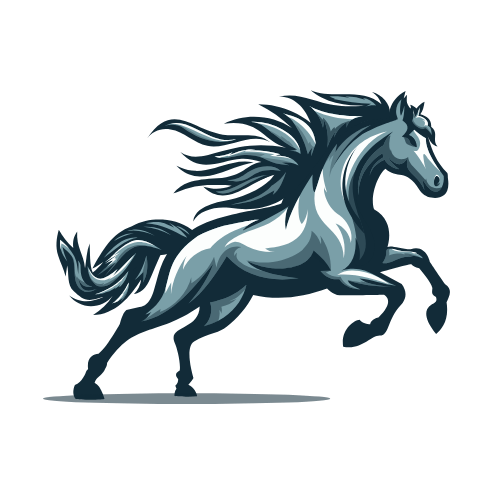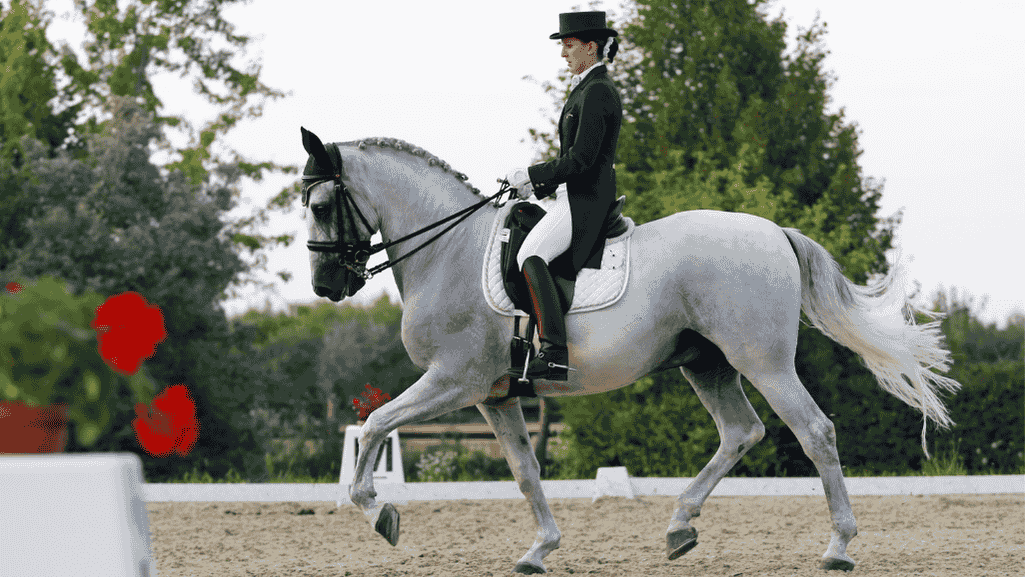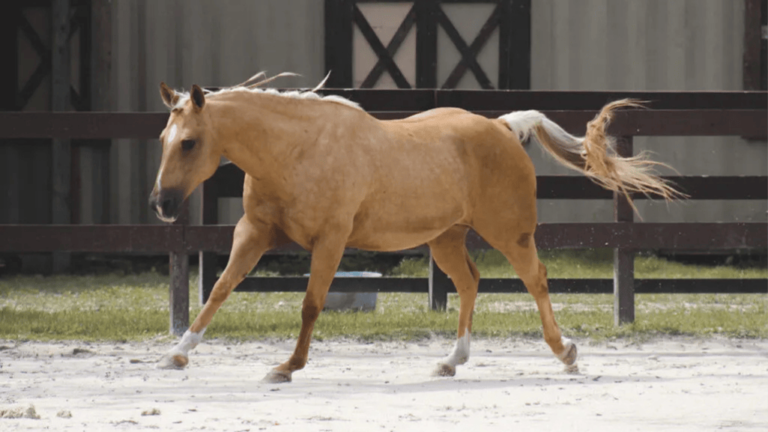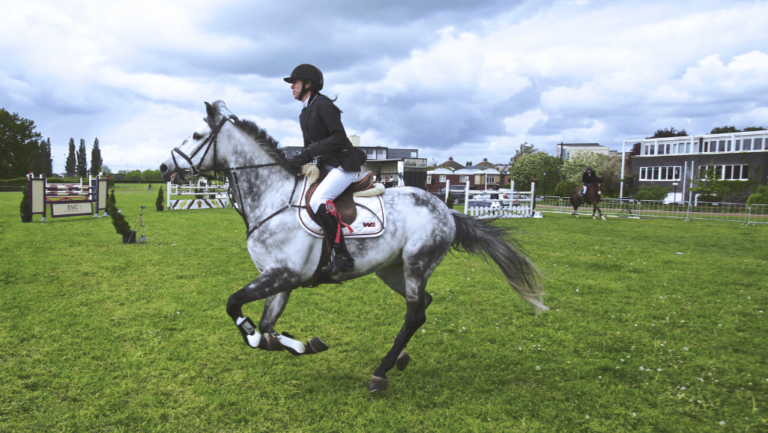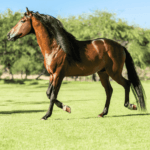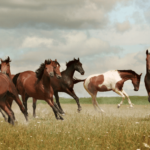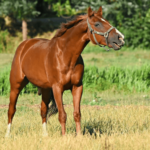Dressage is a beloved equestrian sport that has won the hearts of many. It shows the amazing bond between horse and rider. Together, they perform precise movements, highlighting the horse’s natural talent.
This sport has a long history based on classical riding. Today, it’s a modern competition that requires great skill and dedication from both horse and rider.
The art of dressage is all about trust and communication between horse and rider. Through training, horses become very flexible and responsive to their riders. They show off their strength and agility in movements like the piaffe and passage.
As riders get better, they learn more complex movements. These include half-passes, flying changes, and pirouettes. These skills need a deep understanding of how horses move and a strong connection with them.
The goal of dressage is to create a perfect partnership. Horse and rider should move together in a beautiful display of grace and precision.
Key Takeaways
- Dressage is a growing equestrian sport that celebrates the partnership between horse and rider
- Classical riding principles form the foundation of modern dressage training and competition
- Progressive training methods develop a horse’s natural athleticism, suppleness, and responsiveness
- Advanced dressage movements, such as piaffe, passage, and half-pass, require skill and finesse from both horse and rider
- The ultimate goal of dressage is to create a harmonious partnership between horse and rider, moving as one in a display of grace and precision
Understanding the Fundamentals of Dressage
Dressage is the art of training horses. It focuses on harmony, balance, and precision between horse and rider. Through training and clear communication, it enhances a horse’s natural abilities and willingness to perform.
The Origins and History of Dressage
Dressage’s roots go back to ancient times. Xenophon’s “On Horsemanship,” written around 355 BC, is one of the earliest works on the subject. The Renaissance saw significant growth, thanks to masters like Antoine de Pluvinel and François Robichon de La Guérinière.
The Purpose and Goals of Dressage Training
The main goal of dressage is to create a harmonious bond between horse and rider. It aims to make precise and elegant movements possible. Dressage focuses on the horse’s natural gaits and encourages suppleness and balance.
Dressage competitions showcase the skills of horse-rider pairs. These competitions follow a scale that includes rhythm, relaxation, and more. Judges evaluate the horse’s gaits and the rider’s communication during these fei dressage tests.
The Importance of Horse and Rider Partnership
A strong partnership is key to dressage success. This partnership is built on trust, respect, and clear communication. The rider guides the horse through movements using subtle aids.
Effective communication is crucial. Riders use their seat, leg, and rein aids precisely. The goal is to use light aids to avoid tension in the horse.
Half-halts are important for transitions between movements. They help maintain balance and control. Visualization and a clear mental picture are also vital for harmony and precision in dressage.
“Dressage is the art of teaching the horse to carry you. Riding is the art of learning to be a good load to carry.”
– Richard Weis
By focusing on the horse’s well-being, riders can unlock their full potential. This journey is one of continuous learning and growth. Both horse and rider strive to master the art of communication and expression through movement.
The Dressage Horse: Characteristics and Training
A dressage horse is a special and highly trained equine athlete. They have natural talent and learned skills. These horses show grace, power, and precision, making the equestrian sport beautiful and artistic.
To do well in this Olympic discipline, a dressage horse needs certain traits. They also go through training that boosts their natural abilities.
Desirable Traits in a Dressage Horse
When picking a horse for dressage, several traits are important:
- Conformation: A well-proportioned body with correct angles and balance
- Movement: Elastic, expressive gaits with natural impulsion and cadence
- Temperament: Willing, intelligent, and eager to learn and work with the rider
- Soundness: Healthy, strong, and free from physical limitations or weaknesses
While some horses might naturally be good at dressage, all can get better with the right training.
Progressive Training Methods for Dressage Horses
Dressage training is systematic and progressive. It builds the horse’s strength, suppleness, and responsiveness. The training scale has six key elements:
- Rhythm: Maintaining a steady, consistent tempo in each gait
- Relaxation: Encouraging physical and mental relaxation in the horse
- Connection: Establishing a soft, elastic contact between horse and rider
- Impulsion: Developing powerful, engaged hindquarters for energy and thrust
- Straightness: Aligning the horse’s body and ensuring equal weight distribution
- Collection: Achieving a shorter, elevated frame with lightness and self-carriage
By focusing on these elements in order, the horse gets stronger, more flexible, and coordinated. This makes them perform complex movements with ease and grace.
Developing a Horse’s Natural Athletic Ability
Dressage training aims to improve a horse’s natural athletic ability. It focuses on correct biomechanics and builds strength and flexibility. This helps horses reach their full potential as equine athletes.
| Training Aspect | Benefit to the Horse |
|---|---|
| Improved balance | Enhances stability and reduces risk of injury |
| Increased suppleness | Allows for greater range of motion and flexibility |
| Refined responsiveness | Enables precise communication between horse and rider |
| Enhanced muscular development | Supports the horse’s overall health and longevity |
Through patient, progressive training, dressage horses learn to do amazing things. They perform graceful airs above the ground and powerful, collected movements. These horses show the true beauty and art of dressage by working with their riders.
The Role of the Dressage Rider
In dressage, the rider is key in guiding the horse through beautiful movements. They must communicate well with the horse, keep the right position, and use aids carefully. A good rider knows how to connect with the horse, building trust and understanding.
Essential Skills and Qualities of a Dressage Rider
To be great in dressage, riders need certain skills and qualities. These include:
- Patience and perseverance in training
- Keen observation and attention to detail
- Excellent balance and coordination
- Ability to maintain a calm and focused demeanor
- Willingness to continually learn and adapt
Riders often spend years perfecting their craft. They work with their horses 4-5 days a week. This dedication helps build a strong bond between horse and rider, essential for success in dressage.
The Importance of Rider Position and Aids
The rider’s position greatly affects the horse’s movements. A neutral spine, strong core, and proper leg position are crucial. These help the rider guide the horse smoothly.
Riders in dressage require a strong core and back, as well as proprioceptive skills to be able to respond effectively to the horse’s movements.
The rider’s aids, like weight, legs, and hands, must be used carefully. This helps the horse move fluidly. Developing an independent seat and clear cues is key for advanced movements.
Building a Harmonious Partnership with the Horse
The bond between horse and rider is central to dressage. It’s built through patient training, open communication, and respect. As the rider learns to understand the horse, the horse becomes more confident and attentive.
| Aspect | Importance |
|---|---|
| Trust | Allows horse to rely on rider’s guidance |
| Communication | Clear, consistent cues for understanding |
| Respect | Valuing horse’s wellbeing and individuality |
| Patience | Allowing time for horse to learn and progress |
This partnership allows horse and rider to reach the highest levels in dressage. It shows the beauty and artistry of the sport. The mental connection between horse, rider, trainer, judge, and spectator is just as important as the physical.
Mastering Basic Dressage Movements
Learning basic dressage movements is key for both horse and rider. It helps them move forward in training and do well in competitions. The walk, trot, and canter are the basics, along with smooth transitions between them.
As riders get better, they add lateral movements. These help the horse be more flexible and responsive to the rider’s commands.
The Walk, Trot, and Canter: Perfecting the Gaits
The walk, trot, and canter are the foundation of dressage. They need rhythm, relaxation, and a strong connection between horse and rider. A good walk is active and has a clear rhythm.
The trot is a two-beat gait that needs balance and flexibility. The canter, a three-beat gait, shows roundness and engagement.
“The art of riding is the perfect union between horse and rider, achieved through training and communication.”
Transitions Between Gaits and Within Gaits
Smooth transitions between gaits are crucial in dressage. They show the horse’s obedience and the rider’s skill. Transitions should be done with little aid and keep the horse’s rhythm and balance.
Practicing transitions makes the horse more responsive. It also improves the quality of the gaits.
| Dressage Level | Required Movements |
|---|---|
| Training Level | Walk, trot, canter, 20-meter circles, halt |
| First Level | Lengthenings, 10-meter circles, leg yield, canter serpentines |
Lateral Movements: Shoulder-In, Travers, Renvers, and Half-Pass
Lateral movements are key in dressage. They make the horse more flexible and responsive. The shoulder-in, travers, renvers, and half-pass are common lateral movements.
- Shoulder-in: The horse’s inside front leg crosses in front of the outside front leg, promoting bend and engagement.
- Travers: The horse’s haunches move slightly to the inside track, with the front legs on the outer track.
- Renvers: The inverse of travers, with the horse’s haunches to the outside track and the front legs on the inner track.
- Half-pass: A lateral movement performed on a diagonal line, with the horse’s body parallel to the long side of the arena.
Mastering these movements is the first step to success in dressage. It requires consistent practice, patience, and understanding the horse-rider bond.
Advanced Dressage Movements and Exercises
As horse and rider advance in dressage, they learn more complex movements. These show the highest levels of elegance and precision. They are key in olympic dressage and the toughest dressage tests at top competitions. Mastering these dressage techniques needs a deep understanding of the horse’s body and a strong bond between horse and rider.
Piaffe and Passage: The Pinnacle of Collection
The piaffe and passage are among the most impressive dressage movements. The piaffe is a trot on the spot, showing balance and engagement. The passage is a high trot with a long suspension phase, showing the horse’s strength and coordination.
The piaffe was first used in battle to keep the horse ready while saving energy. Now, it shows the horse’s gymnastic ability and the rider’s skill in achieving high collection.
Pirouettes: Elegance and Precision in Motion
Pirouettes, done in walk and canter, are advanced dressage movements. They need a lot of collection, balance, and precision. In a pirouette, the horse spins around a small circle, with the hind legs making a smaller circle than the front.
To do a pirouette, the horse must be supple and responsive. The rider must also be in the right position and use gentle cues to guide the horse.
Flying Changes: Mastering Lead Changes at the Canter
Flying changes, or tempi changes, are lead changes done in a row at the canter. As the horse trains, it learns to change leads every four, three, two, and one stride. The horse should do these changes with grace and balance.
To do flying changes, the horse needs to be balanced and supple. The rider must have a strong seat and use precise aids to tell the horse how many changes to do.
| Movement | Description |
|---|---|
| Piaffe | An elevated trot on the spot, demonstrating balance and engagement |
| Passage | A very elevated and collected trot with pronounced suspension |
| Pirouette | A circle performed with the hind legs creating a smaller circle than the front |
| Flying Changes | A series of lead changes performed in succession at the canter |
As horse and rider master these advanced dressage movements, they show the highest levels of harmony and artistry. These movements prove the dedication, skill, and partnership needed to excel in dressage.
Dressage Dressage Competitions and Tests
Dressage competitions show the perfect bond between horse and rider. They highlight the beauty and skill of riding movements. These events are run by the Fédération Équestre Internationale (FEI), the top body for equestrian sports. They give riders a chance to show their skills and their horses’ training.
Understanding Dressage Test Levels and Requirements
Dressage has many levels, each with its own tests and rules. These levels go from Introductory and Training to the top, the Grand Prix. As riders move up, the tests get harder, needing more skill and precision.
Each level has its own rules for the horse’s movements. For example, at Introductory Level, horses must show a balanced walk, trot, and canter. At the Grand Prix, they do advanced moves like piaffe and passage, showing the best of horse and rider teamwork.
Preparing for Dressage Competitions: Training and Strategy
To do well in dressage, a horse needs strong training. Riders must start with the basics like rhythm and connection. Then, they can move on to more complex moves.
Both horse and rider need mental preparation too. Building a strong partnership is key for success. Riders should plan their competitions carefully, choosing ones that match their horse’s level and fitness.
Scoring and Judging in Dressage Competitions
Judges score dressage performances from 0 to 10, with 10 being the best. Half points can also be given. They look at each movement and the overall performance of the horse and rider.
The Dressage competition follows a scoring rubric ranging from 0 to 10 with corresponding descriptions:
- 0: Not executed
- 1: Very bad
- 2: Bad
- 3: Fairly bad
- 4: Insufficient
- 5: Sufficient
- 6: Satisfactory
- 7: Fairly good
- 8: Good
- 9: Very good
- 10: Excellent
There are also marks for overall impression, gaits, and the rider’s position. These marks add up to the final score. A score of 60% or more is good, and over 70% is outstanding.
| Rider | Horse | Dressage Penalty Points | Equivalent Percentage Score |
|---|---|---|---|
| Tom McEwen (GBR) | Toledo de Kerser | 25.80 | 74%+ |
| Boyd Martin (USA) | Federman B | 30.50 | 69.5% |
| Caroline Pamukcu (TUR) | HSH Blake | 27.00 | 73% |
| Elisabeth Halliday (USA) | Nutcracker | 28.00 | 72% |
Dressage competitions are a thrilling display of the art of haute école. They show the beauty of horse and rider working together. Through hard work, skill, and partnership, these teams show the true spirit of equestrian sports.
The Art of Dressage: Classical vs. Modern Approaches
Dressage is a refined equine sport that has grown over centuries. It combines classical and modern methods. The goal is to enhance a horse’s natural abilities and build a strong partnership with the rider. Dressage is now a key part of international competitions, including the Olympics.
Classical Dressage: Preserving Traditional Principles
Classical dressage follows the teachings of greats like Xenophon. It focuses on keeping traditional techniques alive. This method emphasizes natural gaits, harmony, and lightness in the horse.
Classical dressage uses specific movements to improve the horse’s strength and reduce wear. This approach helps the horse and rider work together smoothly.
Notable practitioners of classical dressage include:
- Craig Stevens
- Charles de Kunffy
- Philippe Karl
These experts stress patience, subtlety, and clear communication with the horse. Classical dressage is making a comeback, offering benefits like better movement and fewer injuries.
“Classical dressage was developed for the nobility riding Lipizzans, Arabs, and Andalusians, focusing on freedom, balance, and rhythm for soundness in horses as they age.” – Dr. Gerd Heuschmann
Modern Dressage: Evolving Techniques and Innovations
Modern dressage brings new techniques and innovations to the sport. It builds on classical principles but adds scientific insights. This approach aims to improve performance in FEI competitions.
Modern dressage includes:
- Using advanced training tools and technologies
- Stressing precision and technical accuracy
- Adapting training to fit each horse-rider pair
Both classical and modern dressage aim for a harmonious horse-rider partnership. The best approach depends on the horse, not the method. Being flexible and creative in training helps keep horses mentally and physically healthy.
Dressage Training Tips and Techniques
Learning dressage needs a step-by-step plan. It focuses on rhythm, relaxation, connection, straightness, suppleness, and collection. These elements are key for a successful partnership between horse and rider. Together, they can perform beautiful movements like those in equine haute ecole.
Developing Rhythm, Relaxation, and Connection
A consistent rhythm is vital in dressage. It helps the horse move smoothly and in sync. Amelia Newcomb Dressage stresses the importance of a strong bond between horse and rider. This bond is built through trust and a holistic training approach.
Relaxation is key for the horse to listen to the rider’s cues. This makes movements fluid and easy. A strong connection between horse and rider leads to harmony and better communication.
Improving Straightness, Suppleness, and Collection
Straightness means the horse can move in a straight line. This is important for balanced movements. Suppleness allows the horse to bend and use its hind legs well. Collection means the horse can move more easily and lift its front end.
These skills are needed for advanced dressage. They help in performing complex movements seen in FEI disciplines and grand prix competitions.
“Training horses involves communicating through aids of pressure and release: aid, reaction, release, and repetition. The aid should start with the lightest pressure possible, ranging between 1-10, to prompt a response from the horse.” – Amelia Newcomb
Overcoming Common Dressage Training Challenges
Dressage training can face challenges like resistance or tension. But, these can be solved with patience and consistent training. Using the right exercises and techniques helps.
Top riders like Steffen Peters and Christine Traurig have shown success in competitions. Their training methods are effective:
- Steffen Peters has competed in four Olympic Games (1996, 2008, 2012, and 2016).
- Steffen Peters won the 2009 FEI World Cup Dressage Final in Las Vegas aboard Ravel.
- Steffen Peters won individual and team gold medals at the past two Pan American Games.
- Steffen Peters logged his best individual finish of bronze at the World Equestrian Games in Lexington, Kentucky.
- Christine Traurig competed at the 2000 Olympic Games in Sydney, Australia, where her team won a bronze medal.
Riders can improve their communication with horses by using clear aids and rewarding good responses. Doing exercises 3-5 times helps teach the horse. This practice strengthens the bond between horse and rider, aiming for equestrian excellence.
The Benefits of Dressage for Horse and Rider
Dressage is a high form of horse training that benefits both horse and rider. It’s great for competitive dressage, pleasure riding, or other equestrian activities. It improves your horse’s health and your bond with it.
Physical and Mental Benefits for the Horse
Dressage aims to enhance a horse’s natural abilities and willingness to perform. It focuses on precise movements, improving balance, coordination, and fitness. Regular practice boosts muscle, heart health, and endurance.
Dressage also sharpens a horse’s mind. It requires focus, obedience, and quick responses to the rider. This keeps the horse mentally active and reduces stress and anxiety.
| Discipline | Benefits of Dressage Training |
|---|---|
| Endurance Riding | Improved balance, coordination, and cardiovascular fitness |
| Three-Day Eventing | Enhanced responsiveness, elasticity, suppleness, and adjustability |
| Western Riding | Refined communication, balance, and collection |
| Pleasure Riding | Increased flexibility, obedience, and overall well-being |
Improved Communication and Understanding Between Horse and Rider
Dressage emphasizes the partnership between horse and rider. It teaches riders to communicate clearly with their horses. This leads to trust, respect, and a strong working relationship.
As riders get better at dressage, they become more aware of their body and control. This improves their performance and makes riding more enjoyable.
Dressage is a journey of continuous learning and improvement, benefiting both horse and rider physically, mentally, and emotionally. It is a discipline that rewards dedication, patience, and the pursuit of excellence in the art of horsemanship.
The benefits of dressage go beyond competition. It enhances your riding skills and deepens your bond with your horse. Embracing dressage opens up new possibilities for you and your horse.
Famous Dressage Horses and Riders
Dressage has seen many amazing horses and riders leave their mark. Their skills, art, and hard work have set new standards. They inspire many in the equestrian world. Let’s look at some of the most famous horses and riders who have won big in competitions.
Legendary Dressage Horses Throughout History
Many incredible horses have dazzled the world with their grace and talent. Some of the most famous include:
- Valegro: Ridden by Charlotte Dujardin, Valegro won three Olympic golds and one silver before retiring at 14.
- Totilas: This Dutch stallion, ridden by Edward Gal and Matthias Alexander Rath, was known for his powerful moves and won many titles.
- Desperados FRH: Ridden by Kristina Bröring-Sprehe, Desperados FRH won Olympic and World Championship medals.
- Rusty: This Hanoverian gelding, ridden by Ulla Salzgeber, was a top competitor in the late 1990s and early 2000s, winning medals.
In 2022, the dressage world lost many remarkable horses. Horses like Salinero, Satchmo, and others left a lasting impact on the sport.
Notable Dressage Riders and Their Accomplishments
Every legendary horse has a skilled rider behind them. Some of the most notable riders include:
- Isabell Werth: With decades of success, Isabell Werth has won many Olympic, World Championship, and European Championship medals.
- Anky van Grunsven: This Dutch rider has won many titles and is known for her innovative style.
- Edward Gal: Gal has won medals with horses like Totilas and Glock’s Zonik at major competitions.
- Charlotte Dujardin: Dujardin’s partnership with Valegro has been incredibly successful. She has won six Olympic medals, including three golds.
“Dressage is the ultimate expression of horse training and a unique bond between horse and rider.” – Charlotte Dujardin
These riders have not only won big but have also helped grow dressage worldwide. Their hard work and talent inspire many.
Conclusion
Dressage is a captivating equestrian art that shows the deep bond between horse and rider. It requires hard work and mastering complex movements. This leads to grace, precision, and harmony between horse and rider.
The journey of dressage is always growing and learning. It needs constant dedication and understanding of the horse’s abilities.
As riders move up in dressage, they learn to communicate better with their horses. This creates a strong bond that goes beyond the arena. They master movements like the walk, trot, canter, piaffe, and passage. Each movement highlights the horse’s skill and the rider’s guidance.
Dressage has changed over time, blending old and new styles. Yet, its core remains the same: striving for excellence and celebrating the horse-rider partnership. It’s rewarding for those who want to compete or just connect deeper with their horse. As fans keep loving this timeless art, dressage’s future looks bright, full of achievements and love for horses.
